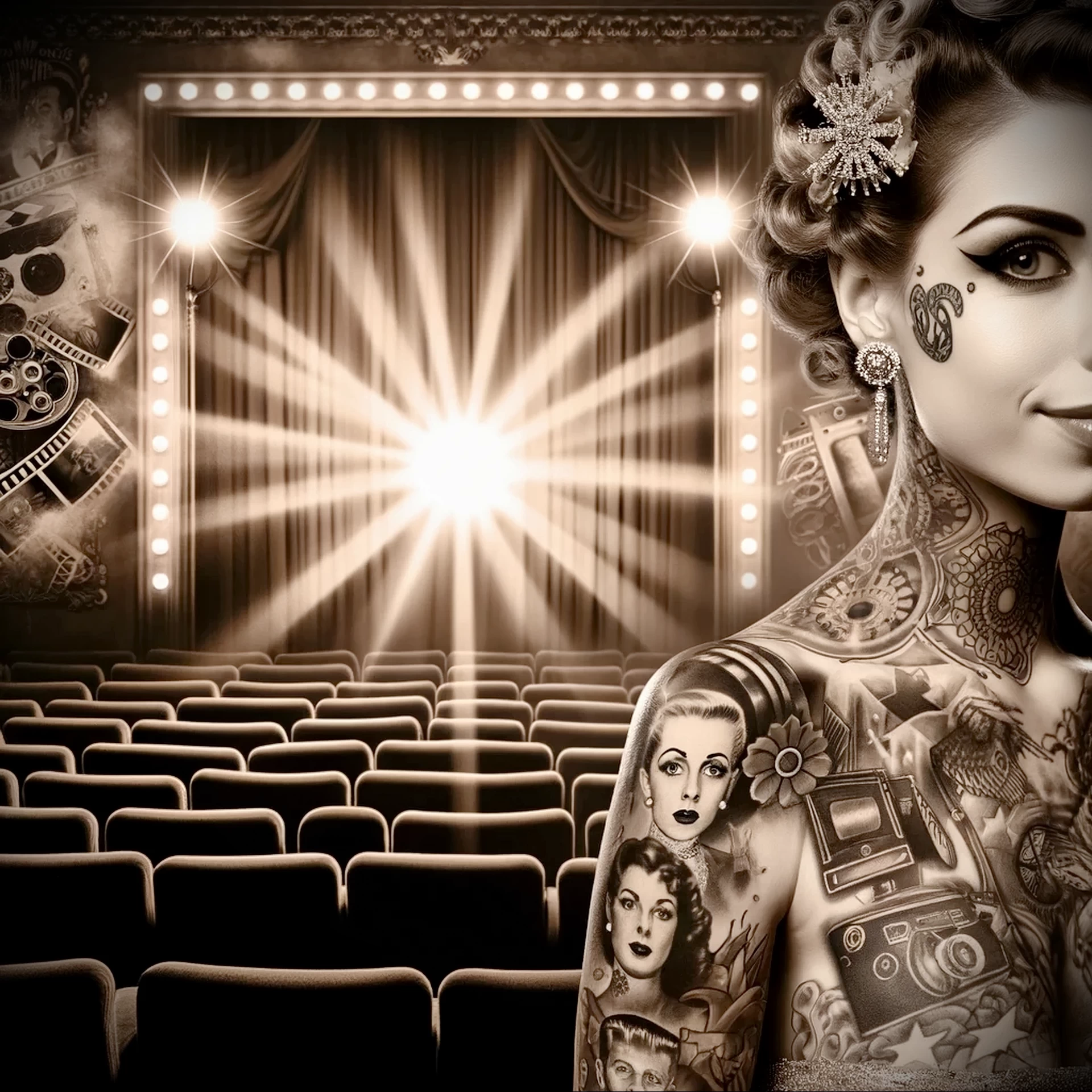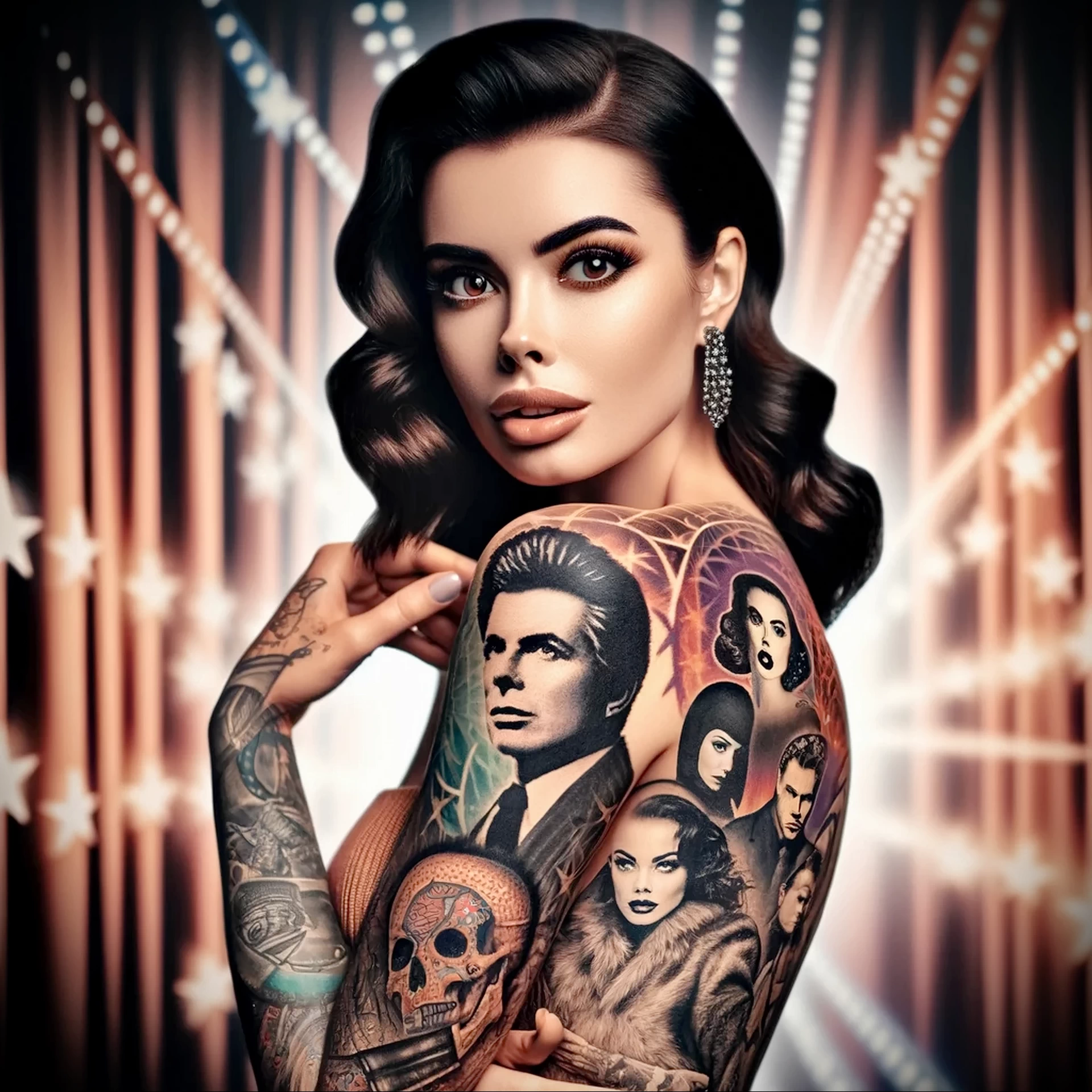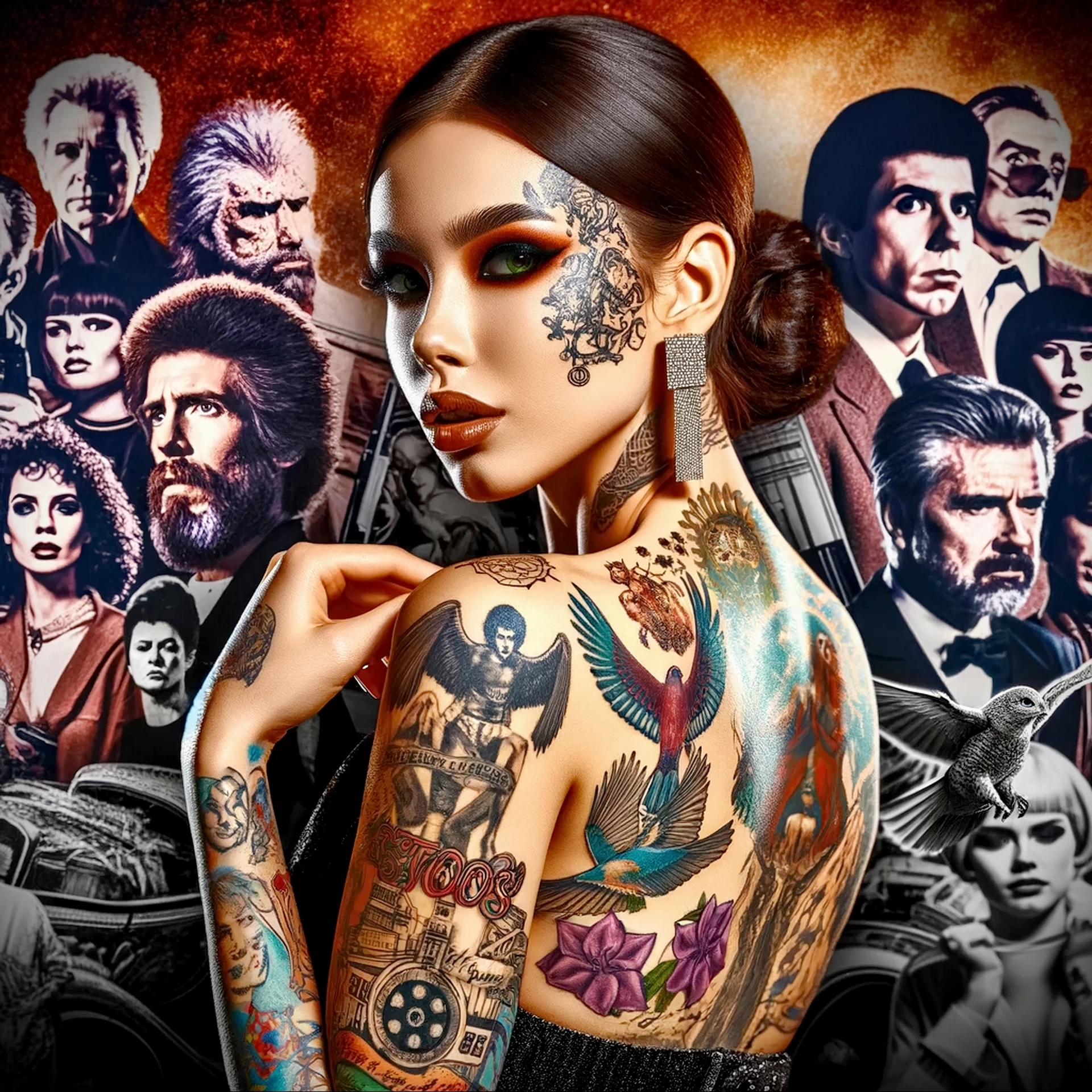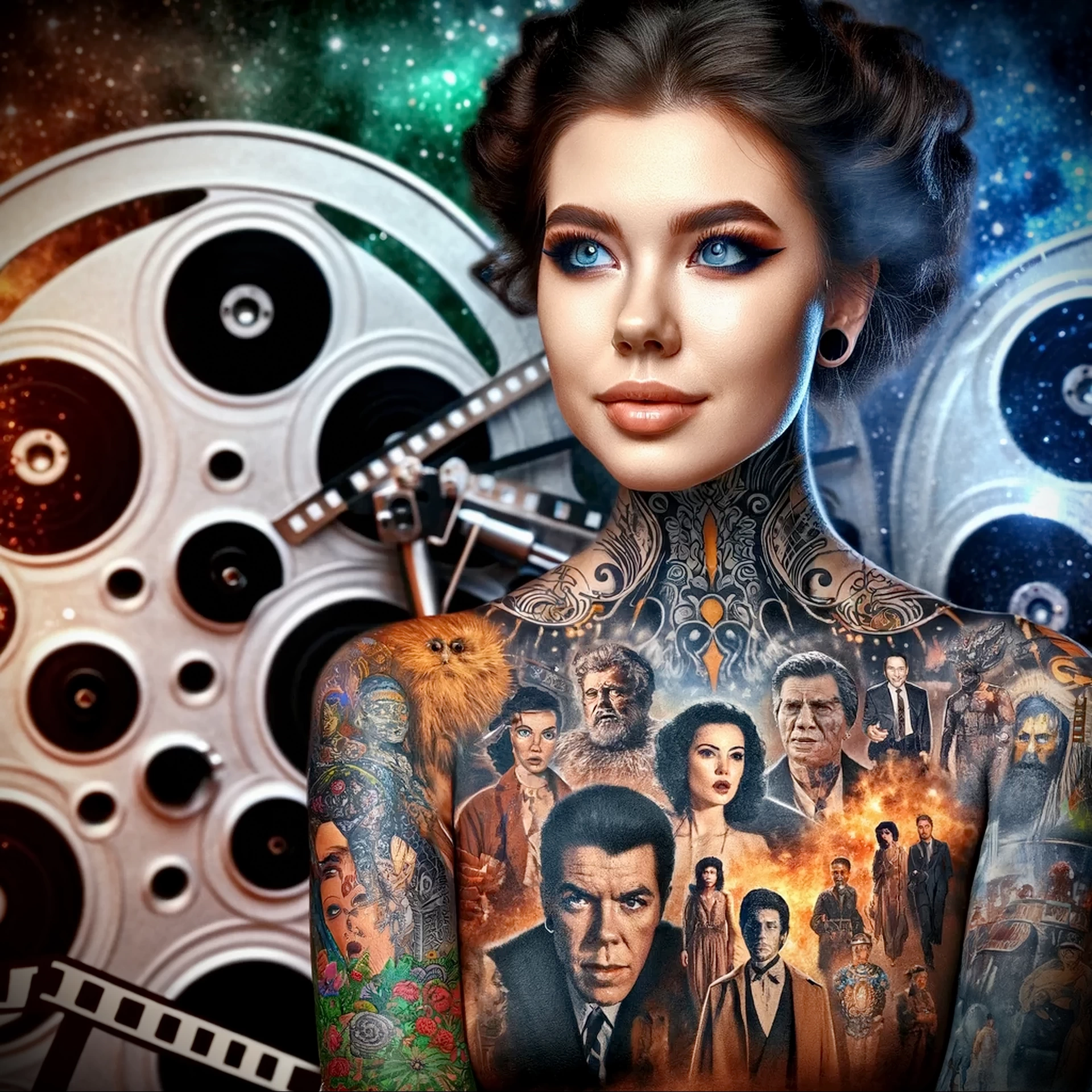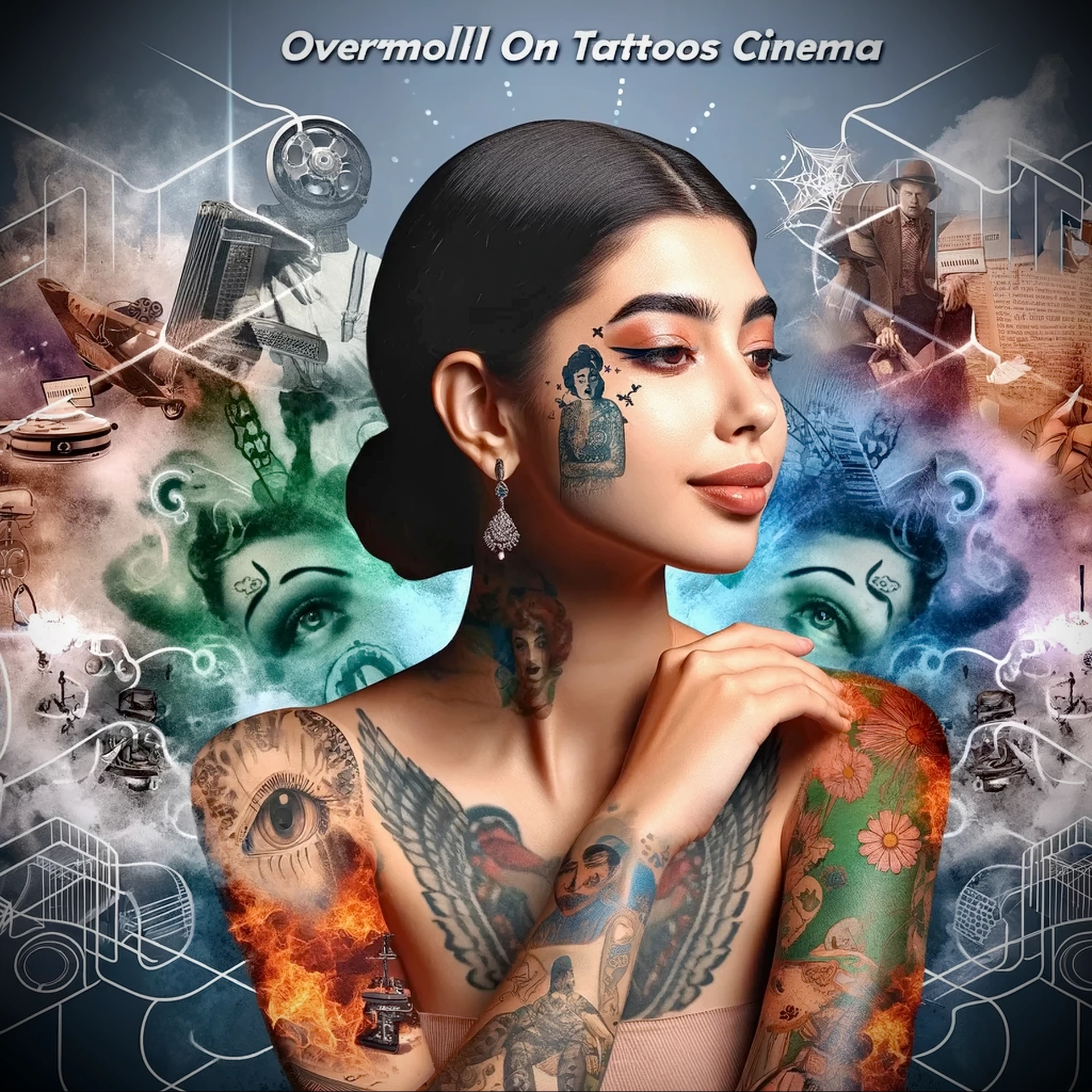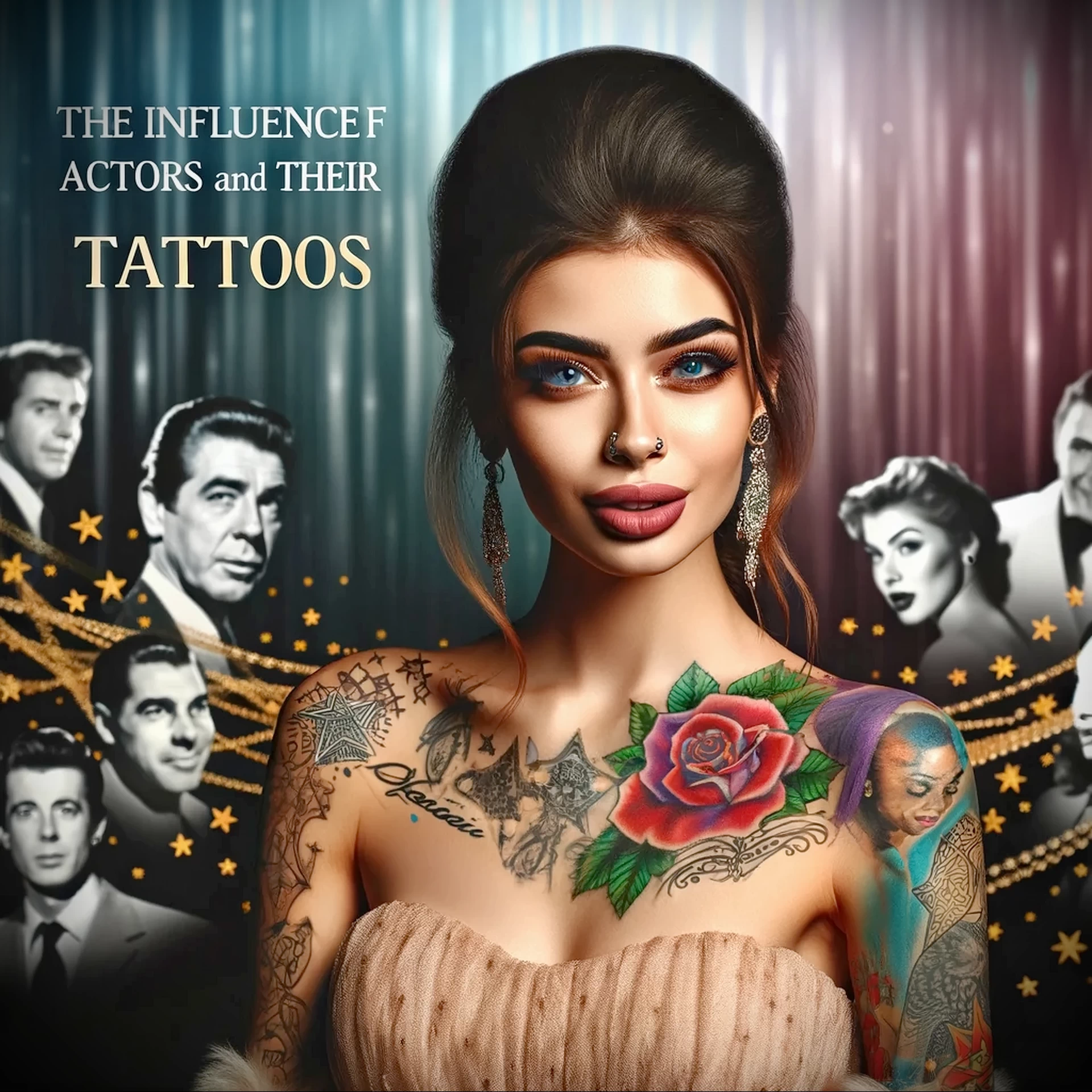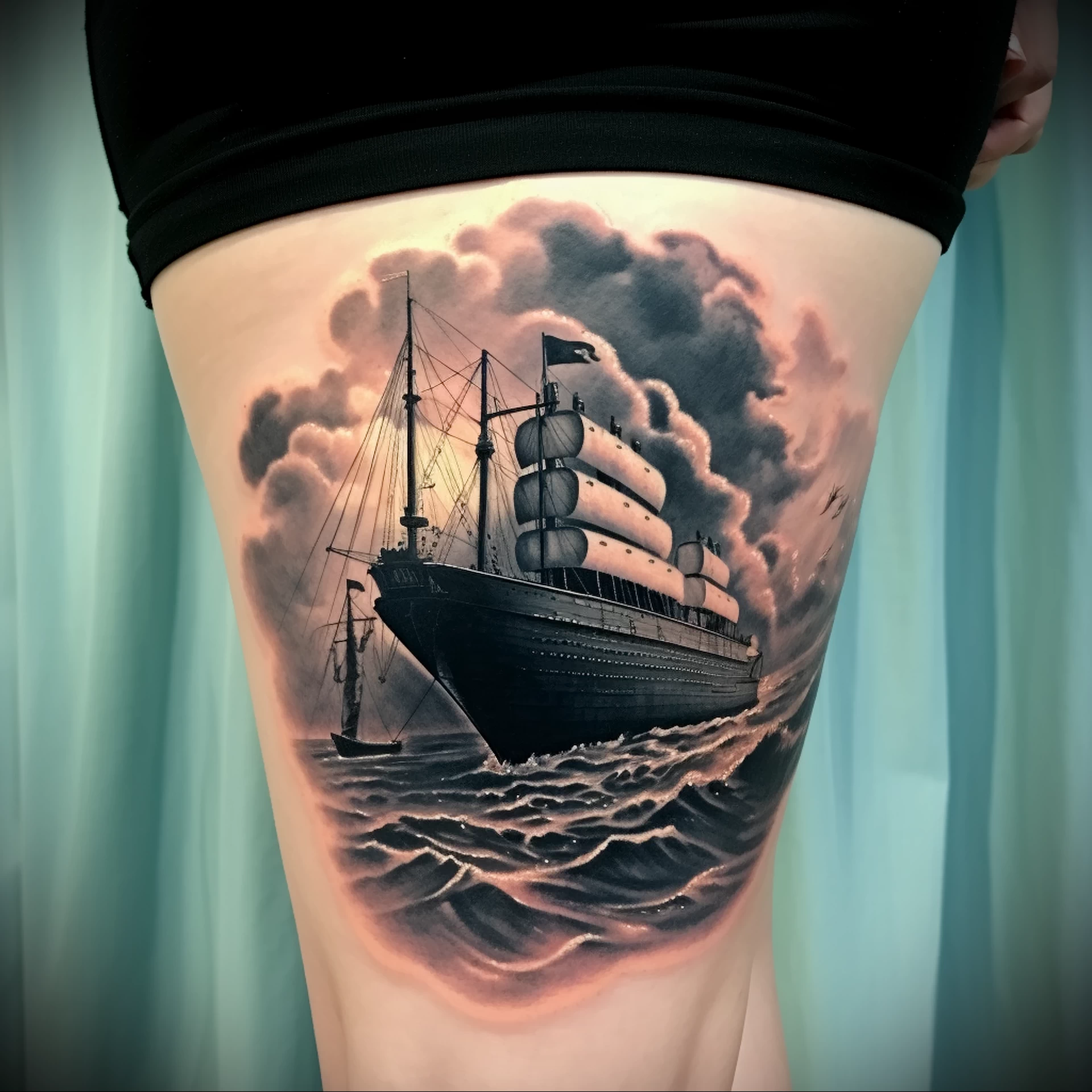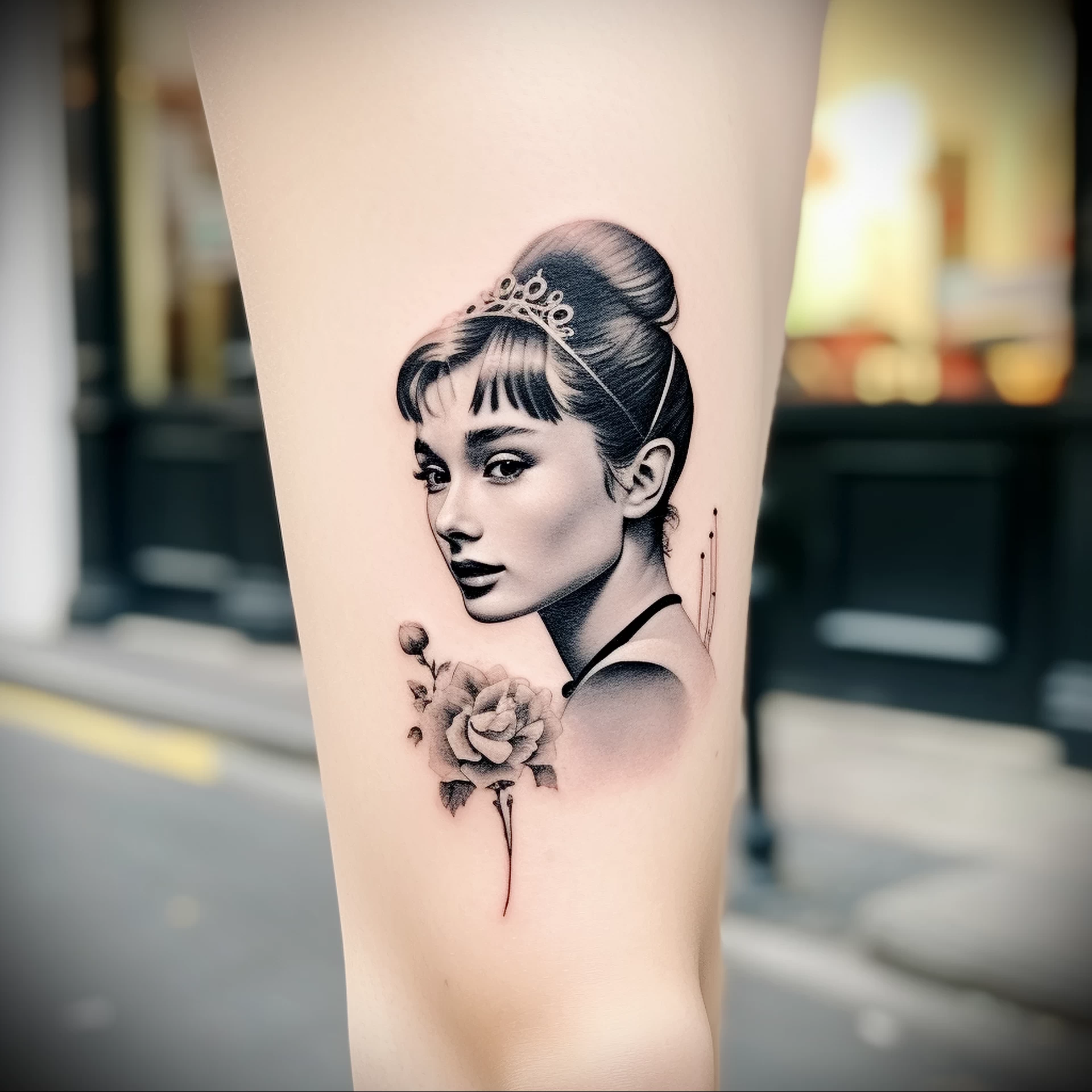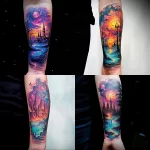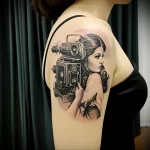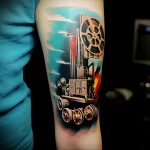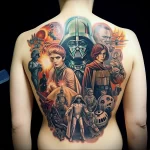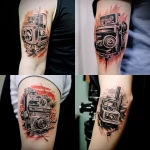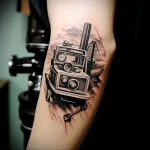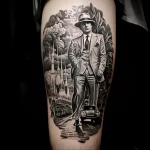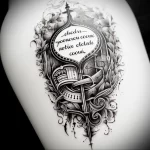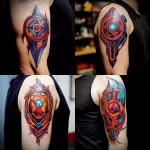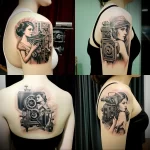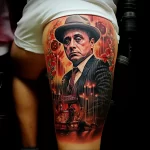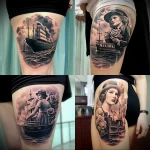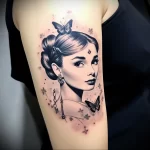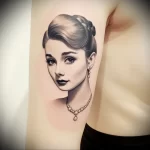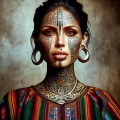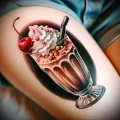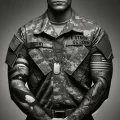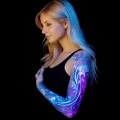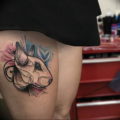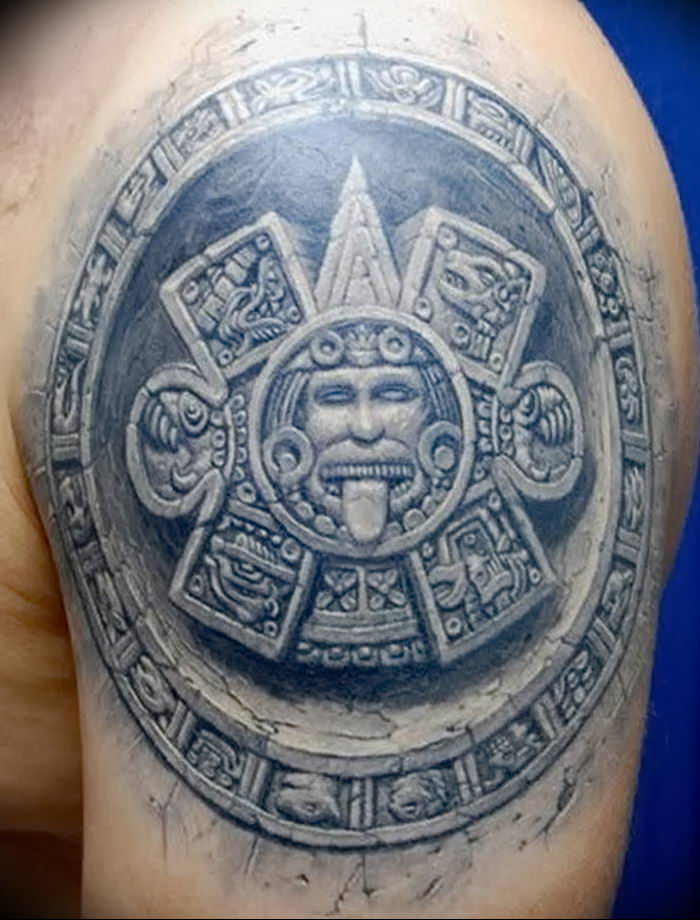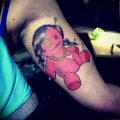Reflecting and shaping cultural trends – that’s what makes cinema special, especially when it comes to tattoos. In this article, we explore how famous movies and characters have influenced the perception and popularity of tattoos, transforming them from symbols of marginality into mass culture trends.
Tattoos have a long and diverse history, reflecting the cultural, religious, and social traditions of various societies. Over the centuries, tattoos have served various purposes: from ritual rites to means of social identification. However, with the development of cinema, tattoos began to play a new role. They became not only an element of personal expression but also an important tool in creating character images, emphasizing their character, history, or even philosophy. The influence of cinema on the popularity of tattoos began to manifest itself as soon as cinema became a mass phenomenon. From early black-and-white films to modern Hollywood blockbusters – each era has contributed to the spread of tattoos as a form of art and self-expression. This article invites readers on an exciting journey through the history of cinema and tattoos, revealing how the interaction of these two aspects of culture has had a profound impact on modern fashion and public opinion.
EARLY EXAMPLES IN CINEMA
In the early 20th century, when cinema was in its infancy, tattoos in films were rarely used and often had a negative connotation. Tattoos were often associated with sailors, criminals, and outsiders in society, which was reflected in cinematic images of the time. One of the first examples where a tattoo played a key role in the plot can be found in the movie “The Sailor with a Tattoo” (1926). In this film, the tattoo was not just an ornament but an important element of the plot, defining the character and fate of the protagonist. These early films had a significant impact on society’s perception of tattoos. They reinforced stereotypes that tattoos were attributes of marginal layers of society or symbols of antisocial behavior. This perception persisted for many decades and only gradually began to change with the development of cinema and changes in public attitudes. Over time, more positive and diverse images of people with tattoos began to appear in cinema. A key moment in this change came with the growing popularity of adventure and travel films, where heroes with tattoos were no longer exclusively associated with negative characteristics. This allowed viewers to see tattoos in a new light, not as a symbol of rebellion or criminality but as an element of art and individuality. Early films formed the initial perception of tattoos in society, but over time, cinema began to move away from stereotypical images, opening new horizons for understanding and accepting this form of self-expression.
CULT MOVIES AND THEIR INFLUENCE
Over time, the influence of cinema on tattoo culture became even more noticeable, especially with the emergence of cult movies in which tattoos played a key role. These films not only showed tattoos in a new light but also significantly changed the public perception of this art. One of the bright examples is the film “Taxi Driver” (1976), in which the main character, played by Robert De Niro, has a distinctive military tattoo. Although the film does not focus on the tattoo, its presence emphasizes the psychological state of the character and his past. This use of tattoos helped create a more complex and deep image. “The Lion King” (1994), a popular animated film, also contributed to the popularization of tattoos. The image of Simba, drawn on the hand in one of the key scenes, became a symbol of courage and bravery for many fans. The movie “The Tattooist” (2007) introduced tattoos as an important element of the plot, linking characters and revealing their stories. This film showed tattoos not just as a decorative element but as a way to tell a story and express deep emotions. “Captain America: The Winter Soldier” (2014) introduced a significant tattoo on the Winter Soldier’s arm, which became a symbol of his transformation and internal conflict. This image showed how a tattoo can become a key element of a character’s visual identity. These films played a significant role in changing the perception of tattoos in society. They moved tattoos from the marginal sphere to the mainstream, showing them as a form of art capable of conveying complex ideas and emotions. Thus, cult films not only developed cinematographic art but also influenced cultural trends, making tattoos more acceptable and popular among the wider masses.
TOP 20 CULT MOVIES THAT INFLUENCED TATTOOS
- “Taxi Driver” (1976) – Robert De Niro’s tattoo symbolized his character and past.
- “The Lion King” (1994) – The image of Simba inspired many to create similar tattoos.
- “The Tattooist” (2007) – A film where tattoos are a key element of the plot.
- “Captain America: The Winter Soldier” (2014) – The Winter Soldier’s tattoo became iconic.
- “Pirates of the Caribbean” (2003-2017) – A film series that popularized pirate tattoos.
- “The Rose Tattoo” (1955) – One of the first cinematic works where a tattoo plays a key role.
- “Dead Men Don’t Wear Plaid” (1982) – A comedy that shows tattoos in a humorous light.
- “Fight Club” (1999) – The film’s influence is felt in the style and design of tattoos.
- “The Matrix” (1999) – Tattoos symbolize certain philosophical ideas.
- “The Lord of the Rings” (2001-2003) – Elvish and other fantasy symbols became popular.
- “Hachi: A Dog’s Tale” (2009) – The image of Hachiko became a popular choice.
- “The Boy in the Striped Pyjamas” (2008) – Numbers of concentration camp prisoners turned into symbolic tattoos.
- “Interstellar” (2014) – Space motifs inspired many.
- “Avatar” (2009) – Exotic tribal tattoos of Pandora became trendy.
- “Eternal Sunshine of the Spotless Mind” (2004) – Tattoos reflecting complex relationships and emotions.
- “Harry Potter” (2001-2011) – Themes of magic and magical symbols.
- “The Hangover” (2009) – Mike Tyson’s tattoo became iconic.
- “Watchmen” (2009) – Comic book heroes and symbolism.
- “Madagascar” (2005) – Animated style tattoos.
- “Venom” (2018) – Superhero tattoos and anti-heroes. These films represent a wide range of genres and styles, but each has influenced tattoo culture, whether through images, symbols, or storylines.
CHARACTERS WITH TATTOOS AND THEIR IMPACT ON CULTURE
In the world of cinema, characters with tattoos often leave an indelible mark on culture, influencing fashion trends and the perception of tattoos in society. These images become a source of inspiration for many, promoting the popularization of tattoos as a form of art and self-expression. One of the most iconic examples is Lisbeth Salander from the “Girl with the Dragon Tattoo” series. Her dark and strong image, underscored by tattoos, became a symbol of independence and strength. The dragon tattoo, covering much of her back, turned into one of the most popular designs among the film’s fans. Jack Sparrow from the “Pirates of the Caribbean” series also had a significant impact on tattoo fashion. His charismatic and eccentric image, complemented by tattoos reflecting the pirate theme, inspired many to create similar designs. Tony Stark’s tattoos in “Iron Man” and other Marvel films also garnered attention. Although not as explicitly expressed as other characters, their modern and stylish design resonated with fans. The character of Mike Tyson in “The Hangover,” with his famous face tattoo, introduced a new element to tattoo culture. This design was so unique and expressive that it spawned a trend for similar tattoos. Thus, famous characters with tattoos play a significant role in shaping fashion trends in the world of tattoos. They not only reflect certain cultural contexts but also contribute to the development of tattoos as a form of art, inspiring people to create unique and meaningful tattoos.
TOP 20 MOST MEMORABLE CHARACTERS WITH TATTOOS FROM CINEMA
- Lisbeth Salander from “The Girl with the Dragon Tattoo” – iconic dragon tattoo on the back.
- Jack Sparrow from “Pirates of the Caribbean” – pirate tattoos adding charisma to the character.
- Tony Stark (Iron Man) from the Marvel Cinematic Universe – modern tattoos highlighting the character’s style.
- Mike Tyson from “The Hangover” – famous face tattoo.
- Jean-Claude Van Damme as Luc Deveraux in “Bloodsport” – chest tattoo.
- John Wick from the eponymous film – extensive back tattoos reflecting his past.
- Drax the Destroyer from “Guardians of the Galaxy” – tattoos covering his entire body.
- Leonard from “Memento” – tattoos serving as reminders.
- Seth Gecko from “From Dusk Till Dawn” – famous pistol tattoo.
- Snake Plissken from “Escape from New York” – cobra on the shoulder.
- Frost from “Blade” – impressive tattoos on the face and body.
- Chloë Grace Moretz as Hit-Girl from “Kick-Ass” – heart tattoo.
- Max Cady from “Cape Fear” – tattoos covering the villain’s body.
- Harley Quinn from “Suicide Squad” – bright and playful tattoos.
- Francis Dolarhyde from “Red Dragon” – full back dragon tattoo.
- Ritchie from “Machete” – cross tattoo on the chest.
- Blade from the eponymous film – characteristic vampire hunter tattoos.
- Jake Sully from “Avatar” – Na’vi tattoos.
- The Sicilian from “The Princess Bride” – chest tattoo.
- Jane Doe from “The Autopsy of Jane Doe” – tattoos telling a story. These characters became unforgettable not only due to their personalities and stories but also their unique tattoos, which added a special flair and depth to their images.
MODERN TRENDS IN CINEMA AND TATTOOS
In modern cinema, tattoos have acquired new forms and meanings, becoming a significant part of the narrative and character portrayal. Many recent films have used tattoos not just as a design element but as a means to convey deep messages and emotions, subsequently influencing current tattoo trends. The film “Suicide Squad” (2016) is a prime example of using tattoos to create character depth. The tattoos of Harley Quinn and the Joker not only emphasize their eccentricity and complex relationships but have also become symbols of rebellion and freedom. These images have inspired many to create similar tattoos, reflecting their individuality. In “John Wick” (2014), the protagonist’s tattoos serve not only as decoration but also as keys to his past and inner world. This highlights the growing trend in cinema to use tattoos to add depth and complexity to characters. The film “Mowgli: Legend of the Jungle” (2018) introduced a new trend in tattoos, showcasing traditional tribal patterns. This drew attention to the cultural and ethnic diversity in tattoos. The influence of series like “Game of Thrones” and “Vikings,” where tattoos are used to emphasize cultural affiliation and historical context of characters, should also be noted. These series have contributed to the revival of interest in historical and traditional tattoos. Modern films and series play a significant role in shaping trends in the world of tattoos. They not only reflect current trends but also contribute to the creation of new styles and approaches to tattooing, making it a more significant and diverse part of contemporary culture.
THE INFLUENCE OF ACTORS AND THEIR TATTOOS
Personal tattoos of actors play a significant role in popularizing this art form, often influencing public opinion and fashion trends. In recent years, many renowned actors have not only showcased their tattoos in films but also actively shared them on social media, inspiring fans and art enthusiasts. One striking example is Johnny Depp, whose tattoos have become part of his image. His tattoos, such as the symbolic triangle above his heart and his son’s name, have become icons for many fans. His style and choice of tattoos reflect his personality and creative approach to life. Angelina Jolie is also known for her tattoos, each of which holds special significance. Her tattoos, including the geographical coordinates of her children’s birthplaces, not only distinguish her as an individual but have also inspired many people to create similar tattoos. Dwayne “The Rock” Johnson is famed for his extensive tribal tattoo, reflecting his cultural heritage and personal history. This tattoo not only emphasizes his physical strength but has also influenced the popularity of tribal tattoos. Rihanna, known for her musical achievements and acting work, has also contributed to the popularization of tattoos. Her exquisite and symbolic tattoos, such as the stars on her back, have become a trend among her fans. These examples show how personal tattoos of celebrities can influence public opinion and fashion trends in tattoos. Their choice and style of tattoos not only reflect their personalities but also inspire people to express themselves through the art of tattooing. This underscores the growing connection between celebrity culture and popular tattoo trends.
THE PSYCHOLOGICAL ASPECT OF TATTOOS IN CINEMA
In cinema, tattoos are often used as a powerful tool to convey the depth of characters’ personalities, their histories, and inner worlds. This use of tattoos in films significantly impacts how viewers perceive tattoos in real life. Tattoos can serve as a visual symbol of a character’s transition through significant life stages or transformation. For example, in “Maverick” (1994), the tattoo on the protagonist’s hand is a testament to his past and a key element defining his identity. This helps viewers better understand the character and his motives. In other cases, tattoos are used to convey a certain psychological state. In “Bird Box” (2018), tattoos on one of the characters reflect his inner world and psychological experiences. These tattoos give the character more complex and multifaceted traits, making his image more memorable and realistic. Tattoos can also be used to create a sense of community or belonging to a specific group or culture, as seen in the series “Vikings.” Here, tattoos not only emphasize the cultural identity of the characters but also help viewers better understand the historical and cultural context. This thoughtful use of tattoos in cinema contributes to changing how viewers perceive tattoos in real life. Tattoos cease to be seen as purely aesthetic or decorative, transforming into a complex and significant element capable of telling a story, expressing emotions, or symbolizing important aspects of personality. This change in perception highlights the importance of tattoos as a form of art and self-expression, possessing deep psychological and cultural context.
OVERALL ON TATTOOS AND CINEMA
The influence of cinema on the popularity and perception of tattoos is undeniable and diverse. The history of film shows how tattoos have transitioned from symbols of antisocial behavior and marginality to expressions of deep personality and cultural identity of characters. This journey of tattoos in the world of cinema reflects broader social and cultural changes in society regarding this art form. Cinema has used tattoos to add complexity and depth to characters, making them more realistic and multifaceted. From intimate and personal stories to symbols of belonging and cultural heritage – tattoos have become an integral part of visual storytelling. This, in turn, has influenced how viewers perceive tattoos in real life, contributing to their decriminalization and recognition as a form of art. Looking to the future, tattoos are likely to continue playing a significant role in cinema. With the growing recognition of tattoos as a form of art and self-expression, we can expect even more creative and diverse use in films. This may include more complex and symbolic tattoos, reflecting new cultural trends and social changes. Cinema not only reflects changes in public perception of tattoos but also actively shapes them. As society continues to evolve and change, we can expect cinema to continue using tattoos as a powerful tool for storytelling, creating unique characters, and expressing cultural diversity.
